
Of the dozens of items we shoehorn into our vehicles before we hit the trail, few are more vital than a means of elevating a vehicle. Whether you get stuck in the sand or shred a tire, the often under-valued all-terrain jack will be your best friend. With regard to vehicle-dependent travel, there are many options: scissor jacks, bottle jacks, air jacks and post jacks.
The first need for raising a wagon was developed centuries ago, and inventors have been hard at work developing ways to make a better mouse trap. This month we are delving into products that will not only take your rig to new heights, but also a host of implements designed to make the task easier.
Testing and Considerations
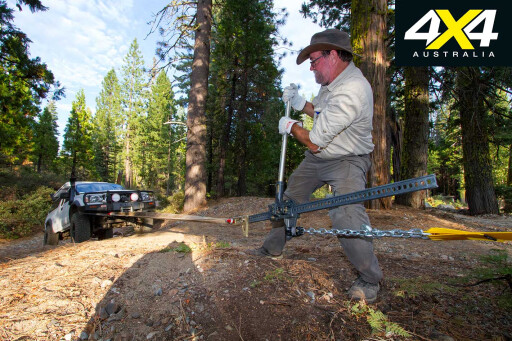 Our evaluation methods for this review were quite simple, and 100 per cent subjective. We took a few vehicles out, buried them in the sand, and utilised each product as specified by the manufacturer.
Our evaluation methods for this review were quite simple, and 100 per cent subjective. We took a few vehicles out, buried them in the sand, and utilised each product as specified by the manufacturer.
We analysed their design, quality of construction from welds to hardware used, weight, storage requirements, cost, and ease of use. In the process we found alternate uses for some, which added value and increased their odds of finding a permanent home in our kit.
The scope of utility for some is very narrow, but in certain environments they would be worth their weight in gold. Not all of the items we tested are featured here, as some did not make the grade. Products reviewed are from Hi-Lift, Safe Jack, Slag Factory, Hard Core Trail Gear, and ARB.
Hi-Lift Jack Extreme 48-inch review

With roots dating back to 1905, before backcountry travel was vogue, the Hi-Lift began life as the Automatic Combination Tool. It was the brainchild of Phillip John Harrah, and would take on monikers such as Farmer’s Jack and Handyman.
During its tenure it would be put into service in World War I, accompany Allied troops during the invasion of Normandy, and be utilised in the most remote corners of the planet and by nearly every major expedition. The old Handyman is indisputably the granddaddy of the lifting genre. Harrah’s firm, Bloomfield Manufacturing Company, is still family run and has earned the right to say, “Don’t buy an imitation.”
During the past 100 years there have been various revisions, but basic design remains the same. The X-Treme, available in 48- and 60-inch models, has a cast steel base and riser unit, 14-gauge high-yield tube handle, and is rated at 4660lb/2113.7kg (tested to 7000lb/3175.1kg).
The riser bar is specially rolled extra-high-carbon steel (80,000lb/36,287.4kg minimum tensile strength), hardware and handle have a weather-resistant zinc coating, and the rest is protected by a charcoal metallic powder-coated finish. Internal pins have a 125,000psi tensile strength, up top is a winch-clamp-spreader tool, and minimum lift height is 4.5 inches.
The versatile tool can double as a winch, press, log splitter, or to reposition a broken spring perch or axle. Quality of construction is unmatched − I’m not sure how they stay in business, as I still have my original unit purchased in 1984. The Hi-Lift is heavy and can be dangerous if not used properly, but this is one tool you don’t want to leave home without. .
Pros: Exceptional versatility; Premium construction; High load rating
Cons: Heavy; Dangerous if not used properly; Moving parts require lubrication
Website: www.hi-lift.com
Bushranger X-Jack review
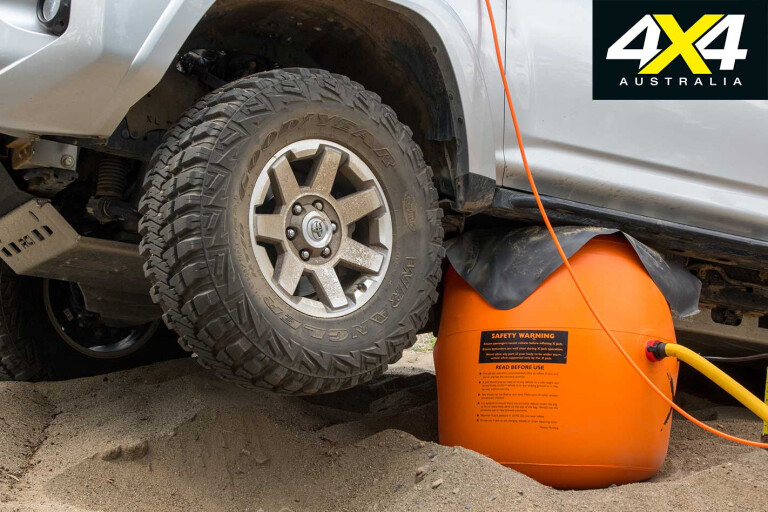
The aim of an exhaust jack is to raise a vehicle in very soft terrain. Place it under the car, attach the hose to the exhaust pipe, and turn on the engine. The exhaust fills the bag with enough pressure to raise the vehicle. There have been some options over the years, but the X-Jack has set the standard.
It is constructed of heavy-duty rubberised canvas with a triple-layer top. A sturdy core insert in the top provides a flat lifting surface, and a protective mat reduces the possibility of damage by irregularities on the undercarriage. It is fully operable at less than 10psi, which is good as engines don’t take kindly to excessive exhaust backpressure.
A mindful feature is the side-mounted valve stem, which allows for inflation via an air compressor. This was important, as the tailpipes on both our test platforms had been strafed on rocks and didn’t provide a good seal. This would also be preferred if the pipe is submerged in mud or water.
The 3628kg capacity is suitable for any medium-sized vehicle, but depending on chassis height, suspension, and how deep the tyres are buried, the 31-inch max lift may not be adequate. In any case, it will lift a tyre high enough to fit a traction mat.
In testing, the X-jack raised our 4Runner in about eight minutes with the engine at 2500rpm. Using an ARB twin compressor, it took less than two minutes. Final internal pressure was 3psi and jack extension was 18 inches, 58 per cent of available lift.
When you reach a lift height, disconnect the tailpipe hose or turn off the compressor. A one-way valve keeps the X-Jack from deflating. Bringing down tyres is as simple as slowly turning an intermediate valve.
Pros: Excellent for intended use; Unparalleled flotation; Quality construction
Cons: Limited lift height; Bulky; Cost
Website: www.bushranger.com.au
Safe Jack Bottle Jack Recovery Kit review
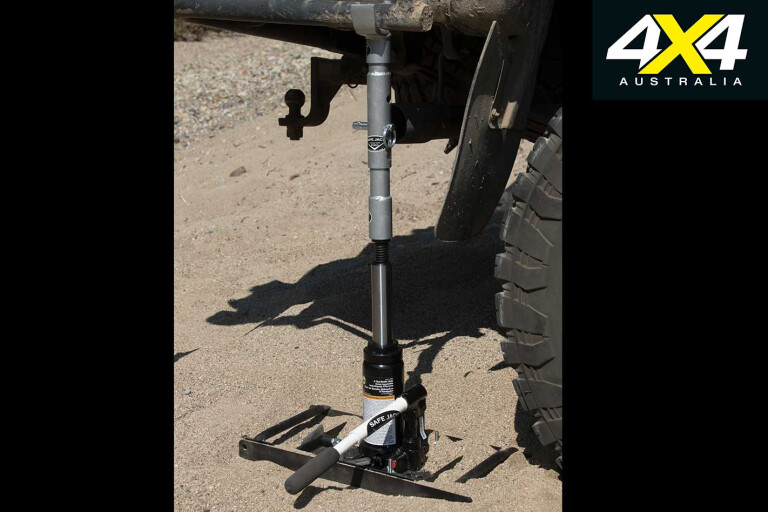
Besides the simple task of lifting a vehicle, I’ve used bottle jacks for everything from raising motors and coercing broken spring perches back in position, to straightening a bent driveline. The problem I’ve run into is that they are often too short to reach the intended target, resulting in adding makeshift piers and compromising safety.
The other issue is that the cap at the top of the riser shaft is usually small, round, and offers a fairly unstable contact patch. Safe Jack’s Bottle Jack Recovery Kit addresses these dilemmas with a number of innovative accessories.
It utilises a standard 5443kg bottle jack but adds three heavy-duty shaft extensions. The extensions slip over the jack’s cap and are kept stable by a tight-fitting collar. There are two top pads: a flat version for lifting a frame or similar surface, and a cupped pad for axle tubes, leaf springs and other curved objects. Construction of all components is excellent, and the kit includes a six-ton hydraulic jack, handle, 3-, 6- and 12-inch extensions, pads, and one of the best canvas carry bags we’ve seen.
The products exceeded expectations. In addition to conventional under-axle use, with the 12-inch extension attached we were able to raise the vehicle from the bumper. A drawback is the jack’s limited shaft stroke, which is about seven inches. I’ve slipped this gear into my rig and retired my well-used OE bottle jack.
Pros: Excellent construction; Increased stability and safety; Expands utility of conventional jack; Heavy-duty carry bag
Cons: Cost
Website: www.safejacks.com
The Jack Foot review
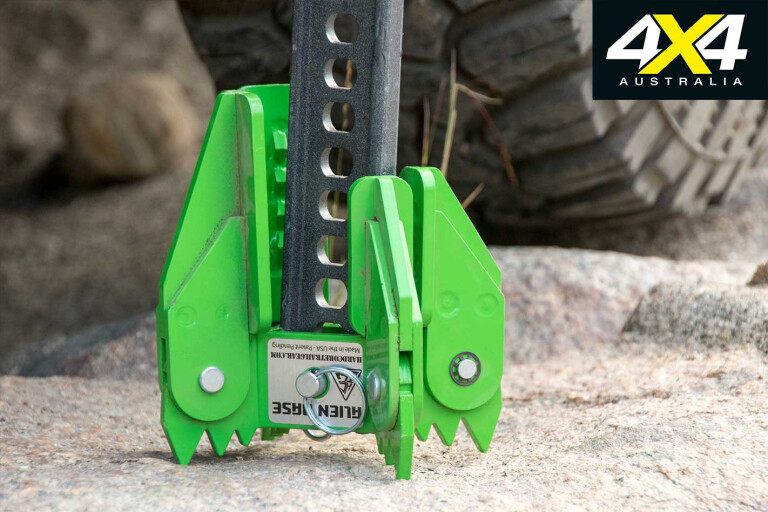
You don’t choose where you break down or get stuck. On uneven terrain, the Slag Factory’s Jack Foot will make the task of lifting a vehicle much easier and safer. Laser cut from 3/16th-inch steel and formed on a CNC bender, it features a wide, pyramid design with jagged teeth.
The teeth are strong enough to support the full weight of most vehicles, even if only a few are in contact with the ground. There are also teeth inside the pyramid, strategically positioned to grab the tops of rounded rocks. In soft dirt and sloped terrain, the teeth cut into the soil and hold firm.
Another advantage when working in sand, snow or mud, is that the base is wide enough to keep it from sinking in too far. The Jack Foot suits all soil types and is compact enough to be permanently mounted on your Hi-Lift.
Pros: Increased footprint and grip; Articulating mount; Excellent construction; Cost
Cons: Weight
Website: www.slagfactory.com
Safe Jack Universal Combination Stabilizer review

Anyone who has attempted to lift a vehicle from a soft surface will appreciate Safe Jack’s stabiliser system. The problem is that the jack base does not have enough surface area, thus the ground load exceeds what the soil can support and your lifting implement slowly sinks.
As we have discussed, the Hi-Lift is an indispensable tool, but herein resides a love-hate relationship. The base is quite small, and when extended and supporting a vehicle the assembly resembles an elephant on a pogo stick. Fortunately, the Universal Combination Stabilizer (UCS) addresses both issues.
Cut from powdercoated 10-gauge plate steel, its base measures 18x8-inch, thus increasing the footprint and adding what you might call a flotation property. The kit includes two insert plates, one for a bottle jack and another for a Hi-Lift, which fit into the base and are locked in position with a spring-loaded retainer pin. The former will accept hydraulic jacks up to 7 inches square, or 4.5 inches when using the provided clamp hardware. The latter accepts a Hi-Lift foot and features a 3/8th-inch steel rod on one end to keep it in place.
The initial setup for the bottle jack insert requires centreing the unit on its insert plate, then positioning the hardware and clamps. This is a bit fiddly and I highly suggest setting it up prior to hitting the trail. You will also want to mark how the jack sits on the insert plate to expedite future use.
The Hi-Lift insert works on the principal of triangulation. Two lengths of 5/32ths steel cable, one attached to each end of the base, are connected to a bracket near the top of the jack. When assembled it forms a triangle, the most stable geometric figure, and adds significant lateral stability.
During testing we lifted the both wheels of the Tacoma off the ground, which would normally send the elephant tumbling left or right. The UCS held tight, even when given a good shake to and fro.
It is available for 48- and 60-inch jacks, and construction, as with the other Safe Jack components in the review, is top notch. My only suggestions would be the addition of a traction surface on the bottom and enlarging the Bottle Jack Recovery kit carry bag to accommodate the stabiliser plate.
Pros: Expands use of conventional jacks; Large footprint; Heavy-duty construction; Improves safety
Cons: Cost; Weight
Website: www.safejacks.com
Hard Core Trail Gear Alien Base review

When using the Hi-Lift on a hill or rocky surfaces, the terrain has made for fairly sketchy operation; either the stock foot was too small or its semi-smooth surface could not gain purchase. Hard Core Trail Gear addresses these issues with the Alien Base.
Designed to replace the OE foot, it incorporates four foldout legs that nearly triple the overall footprint. The contact patches are serrated to grip the soil, and detent springs keep the legs in either the open or closed position.
A triangulated teeth unit on the top allows it to be mounted upside-down (which becomes right side up) when needed. CNC milled from ¼- and 3/8th-inch plate steel, the Alien Base impressed on soft sand, sinking just a few inches. On cambered granite it held tight with only two teeth in contact.
Pros: Versatile lifting options; Improved safety; Quality of construction
Cons: Cost; Weight
Website: www.hardcoretrailgear.com
Hi-Lift Off-Road Base review
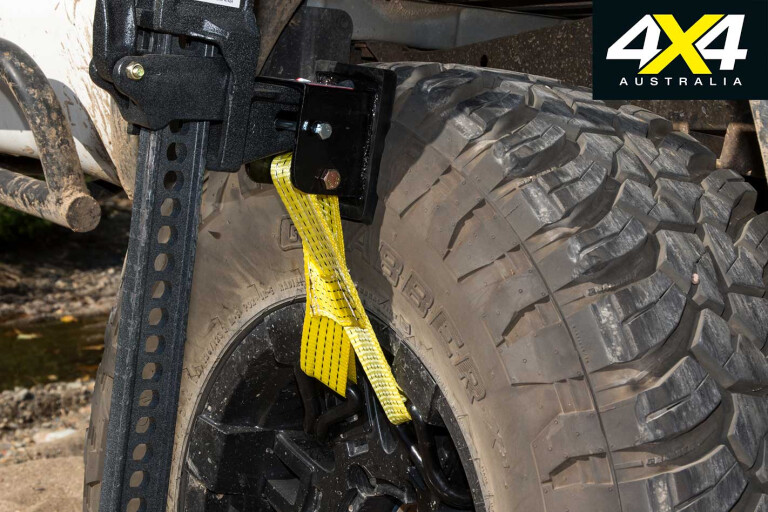
I have had an Off-road Base in my rig for decades and used it countless times. It has been around forever and is about as simple as it gets – just a big plastic platform for working in soft terrain. There have been times when it sank into oblivion (there is an attachment eyelet for a recovery tether), but in most sandy, snowy or muddy conditions it has worked like a charm. And, it won’t cost you a kidney and three pints of blood – love it!
Pros: Increased footprint; Durable; No moving parts; Lightweight; Cost
Cons: Does not hard-mount to jack; Weight
Website: www.hi-lift.com
Safe Jack Secure Lifter, Chain, and Lifting Sling review
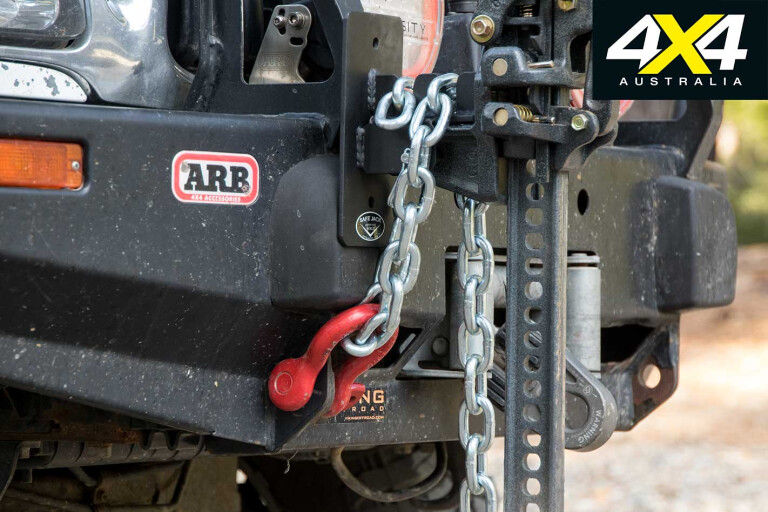
The Secure Lifter, which is designed to be used with a Hi-Lift jack, is a simple idea properly applied. Its purpose is multifold: raise items with odd surfaces or that are lower than a Hi-Lift’s minimum height, keep the jack post away from the subject being lifted, and to increase safety. As with the other Safe Jack products, construction is excellent, steel components are powdercoated black, and an instruction manual is provided.
The unit attaches to the jack’s lifting nose and is secured with a quick-release pin. The outer edge features an abutment plate that rests against a tyre or other object to avoid interaction. On its upper edge are two slots designed to accept and secure a chain. The 4-foot polyester sling, rated 12,400lb/5624.5kg in a basket configuration, is used to loop through spokes in a wheel and back to the Secure Lifter.
Used in the same arrangement, the 3/8th-inch Grade 30 chain (2650lb/1202kg; basket) is handy for attaching a bumper, rock slider, or other hardware. Testing both applications went without a hitch; my only suggestion would be the addition of a rubber pad on the abutment plate to protect painted surfaces. The combination of these three tools could be an asset when a suitable and safe lifting surface is unavailable.
Pros: Works well for intended use; Quality construction; Versatile lifting options
Cons: Needs protective pad; Cost
Website: www.safejacks.com
Hi-Lift Lift-Mate review
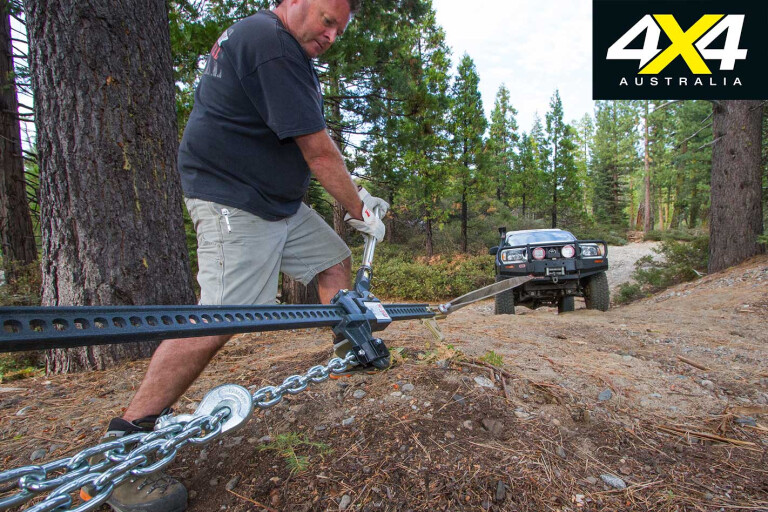
Handy for rigs that don’t have conventional attachment points for a Hi-Lift jack, the Lift-Mate consists of a heavy-duty steel bracket that fastens to the jack nose. Hanging from the bracket is a polyester web sling fitted with two rubberised steel hooks. Slip the hooks into two voids of a wheel and you’re ready for business. As you raise the jack, a large rubber pad on the bracket presses against the tire to stabilise the system.
Pros: Works well for intended use; Quality construction; Cost
Cons: None we found
Website: www.hi-lift.com
Hi-Lift Off-Road Kit review
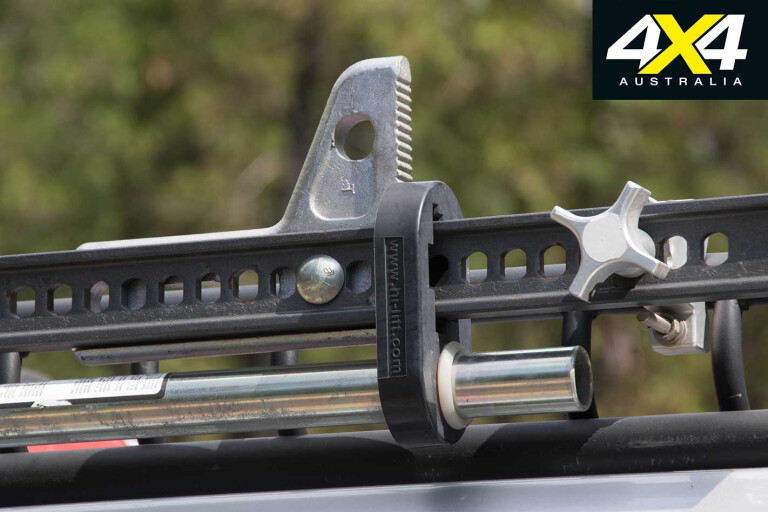
In the days before I could afford an electric winch I used various methods to extract my rig from a bog, the most common of which were a shovel and $30 come-along. The system was not rated for the loads we put it under, and often failed.
If you called the Off-Road Kit a poor man’s winch, you would be correct. But this thing works, and works well. When assembled with a Hi-Lift jack, concept is straightforward, portable, and does not rely on the engine or its electrical system.
There are multiple components: two brackets, two lengths of 3/8th-inch chain with hooks, bow shackle, nose bracket, and a 5000lb/2267.9kg WLL tree strap. Set-up is a four-step process: attach the nose bracket to your Hi-Lift and bow shackle to the top; wrap the strap around a deadman (tree or other fix object) and thread a chain and hook through the eyelets; attach the other chain and hook to a recovery strap attached to your vehicle; and attach loose ends of the chains to nose bracket and bow shackle.
In the same way that the jack will raise a vehicle, it will also pull one. It can also be used to move boulders or logs off the trail, reposition a wayward axle, or pull just about anything you can attach a strap to.
I must say that utilising a Hi-Lift in this manner is a complicated process, and as with any recovery scenario, the due diligence should be exercised (as if it were a live winch line) to ensure safety. Progress is in three-foot increments and in the interim a secondary safety chain must be used to stabilise the vehicle prior to setting up for another pull. Work gloves and canvas carry bag included.
Pros: Quality construction; Excellent for intended use; Cost
Cons: Light-duty bag
Website: www.hi-lift.com

COMMENTS